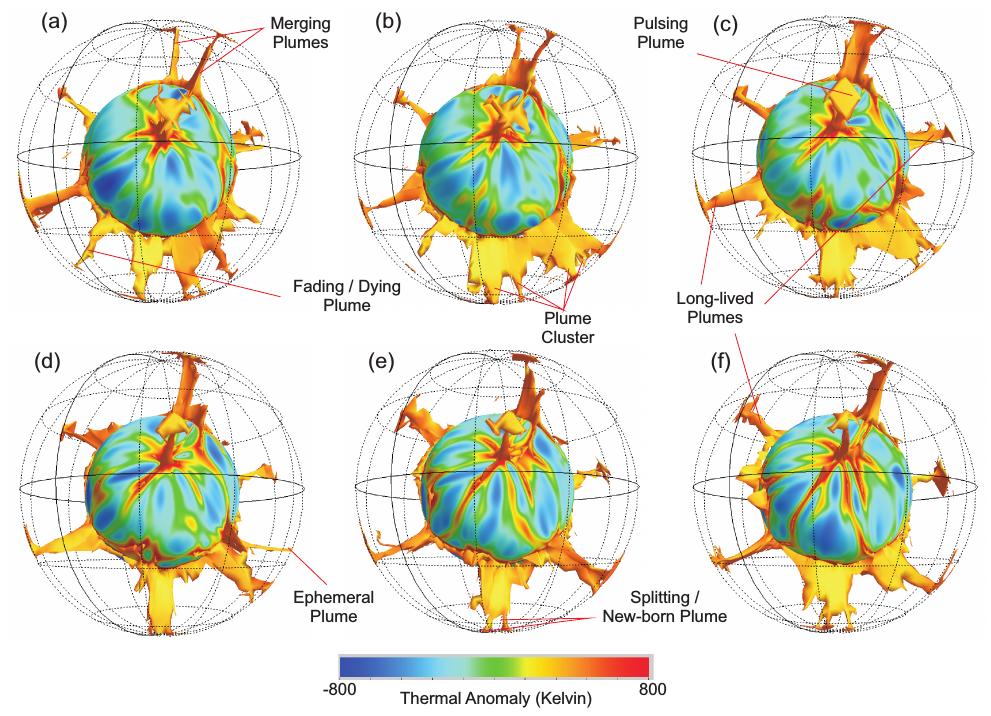Pulsing Mantle Plumes: Causes And Geological Consequences
Motivation & Scope:
Mantle convection is the principal control on Earth's thermal and geological evolution. It is central to our understanding of the origin and evolution of tectonic deformation, the thermal and compositional evolution of the mantle and, ultimately, the evolution of Earth as a whole. Plate tectonics and volcanism are surface manifestations of mantle convection, which, in turn, control multiple surface processes, such as mountain building and sea level change. By transferring heat to the surface, mantle convection dictates the cooling of Earth's core and has a direct impact on the geodynamo. Understanding convection within Earth's mantle was recently designated one of ten `Grand Research Questions in Earth Sciences' in a US National Academies report.
One of the most fundamental gaps in our understanding of mantle convection lies in the dynamics of upwelling mantle flow (i.e. mantle plumes) and the signature of such flow at Earth's surface. While mantle plumes have been extensively studied, certain aspects of their evolution remain poorly understood. There is increasing evidence for temporal variations (hereafter termed `pulses') in plume morphology, temperature and mass-flux. Such pulses produce corresponding changes in elevation at Earth's surface (i.e. dynamic topography - the vertical displacement of Earth's surface generated in response to flow within the mantle). This has major implications for the sediment routing system (i.e. the integrated geomorphic system involving sediment liberation, transport and deposition), influencing the evolution of sedimentary basins and, consequently, hydrocarbon prospectivity (e.g. White, 1997). Moreover, the pulsing Icelandic mantle plume has played a central role in controlling regional uplift, which, in turn, has moderated overflow of North Atlantic Deep Water across the Greenland-Scotland Ridge. Pulsing mantle plumes therefore have a direct influence on large-scale ocean circulation and global climate change (Wright & Miller, 1996, Poore et al. 2009; 2013).
While the observational evidence for pulsing is now increasing, it remains unclear why plumes show such temporal variations in their behavior. It is not known what dictates the strength and frequency of these pulses. Neither do we understand how such pulsing is accommodated within Earth's asthenosphere - the low viscosity region of the mantle immediately below the lithosphere, which plays a central role in facilitating surface deformation. Without a quantitative model of the controls on such pulsing, it is extremely difficult to predict and understand the surface expression of mantle plumes. The overarching aims of the proposed research therefore are: (i) to determine the cause of pulsing mantle plumes; and (ii) to establish a relationship between pulsing plumes and their surface manifestation. These are critical if we are to understand Earth's geological history and the long-term evolution of Earth's mantle.

Figure 1: Satellite-derived free-air gravity anomalies (mGal) in the region surrounding Iceland. Reykjanes ridge is the linear high (bold line) that bisects V- shaped features pointing southward from Iceland. Similar, though less regular, lineations are evident to the north (Ito, 2001).

Figure 2: A series of thermal profiles, displaying the temporal evolution of a mantle convection simulation, with free-slip and isothermal boundaries, at a Rayleigh number of 109 . Snapshots are spaced 30 Myr apart and are surrounded by a latitude- longitude grid. The scale illustrates the temperature, away from the lateral average. Each snapshot shows a radial surface just above the CMB and a hot isosurface, representing regions of the mantle that are 500K hotter than average for their depth. The most prominent features are hot upwelling plumes. These display a range of characteristics. The majority are long-lived and migrate slowly across the mantle. Others are more mobile and ephemeral. New plumes form and old ones fade, some of which eventually cease. Smaller plumes merge together and coalesce over time, while long-lived plumes often pulse or vary in intensity (Davies & Davies, 2009).
Objectives:
Over the last five years, we have developed sophisticated tools for numerically simulating mantle convection, whilst also demonstrating the power of these to improve our understanding of mantle dynamics. The objectives of this project are to apply these tools to better understand the causes and consequences of pulsing mantle plumes, addressing the following questions:
- Why do mantle plumes pulse and what controls the frequency and strength of this pulsing?
- What is the surface manifestation of this pulsing and what can surface observations tell us about the nature of upwelling flow within Earth's interior?
For part 1, a range of hypotheses will be tested on the cause of pulsing plumes. For example, that pulses result from the complex interaction of plumes and mineral phase boundaries, or that pulsing is a consequence of counteracting thermal and compositional buoyancy forces at the base of a plume conduit. Each hypothesis will be validated by comparing model predictions of pulsing behavior with a range of geological observations. Part 2 will focus upon spatial and temporal variations in plume-induced dynamic topography and its influence upon the geological evolution of the North Atlantic Ocean. The wealth of observational constraints available in the North Atlantic will be utilized to examine the connection between Earth's surface processes and its internal dynamics. This is an essential goal for the Earth sciences.






